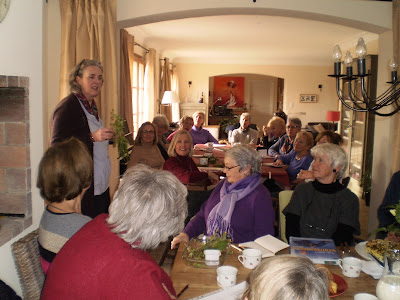The subject we discussed in our January meeting was 'wild edible plants'. Here in the Provence, there are many edible greens even at this time of the year. To demonstrate how tasty they can be, Mavis made a 'Baked Greek Omelette', and I made a 'Cress soup'. We used the most common wild greens we could find at this time of the year. One of them was Cardamine hirsuta (Hairy Bittercress).
It seeds itself all over the garden, and is often considered to be a pest. Once you've tasted this weed, you'll be collecting and adding it to your salads. It has a sharp, peppery taste, very much like Watercress.
Another very common edible plant we used was Diplotaxis erucoides (False Rocket). So easy to pick, it grows everywhere. You can use it instead of spinach.
In autumn and again in spring young shoots appear. The new, young leaves are very tasty in salads. Now in January, they are more suitable to be used in soups, stir fries or other cooked dishes.
We both used Urtica dioica (Nettles) and Rumex acetosa (Wild Sorrel). Wild Sorrel is easy to recognise as the bottom part of the leaf has tails, which you can clearly see on the drawing. It has a distinct sour flavour. It is not necessary to keep strictly to the plants mentioned in the recipes. Whatever edible plant you can find, will do.
The following is the 'Baked Greek Omelette' Mavis made. It is one of Rick Stein's recipes from his book 'Mediterranean Escapes'.
Ingredients: 3 tablespoons of extra virgin olive oil; 250 grams of leeks, trimmed, cleaned and thinly sliced; 250 grams of mixed greens consisting of 60 grams of False Rocket, handful of nettle tops, 1 handful of radish tops, 1 handful of baby spinach, 2 handfuls of small Italian Blet, including some chopped stalks for texture, some Dandelion leaves, some Hairy Bittercress; 8 large eggs; 3 tablespoons of mint and parsley; 3 tablespoons of dill; 175 grams of Greek feta cheese, crumbled; 25 grams grated Pecorino cheese; salt and freshly ground pepper; grated nutmeg.
Preheat the oven to 160 C/Gas Mark 3. Heat 2 tablespoons of the olive oil in a deep frying pan over a medium heat. Add the leeks and cook gently for 10 minutes until soft. Add the remaining oil and the mixed leaves to the pan and cook for 3-4 minutes until they have wilted down and are just tender. Tip the greens into a bowl and add the eggs, mint, parsley, dill, crumbled feta, grated Pecorino, 1/2 teaspoon of salt, some black pepper and nutmeg. Oil a shallow, round, 20-cm non-stick cake tin, pour in the mixture and bake for about 45 minutes or until just set.
The Cress soup is based on a recipe of Antonio Carlucci.
Ingredients: 1 small onion; 4 potatoes; 2 leeks; 1 large carrot; 1 litre stock; 25 grams of Stinging Nettles; a handful of Sorrel; 30 grams of False Rocket; 2 large handfuls of Hairy Bittercress; salt and pepper to taste; 25 grams of butter; 2 tablespoons of olive oil.
Chop the onion, potatoes, leeks, carrots into chunks. Heat the oil in a pan and saute the onion, potatoes, leeks and carrot for 1-2 minutes. Add the stock, bring to the boil, add all the other greens except the Hairy Bittercress and cook gently for 15 minutes. Add the butter and the Hairy Bittercress, liquidize the soup until smooth.














